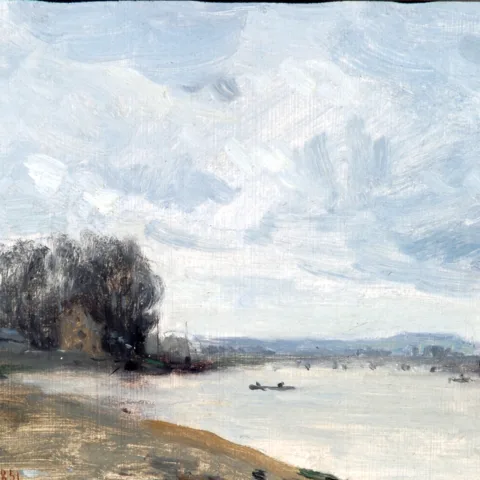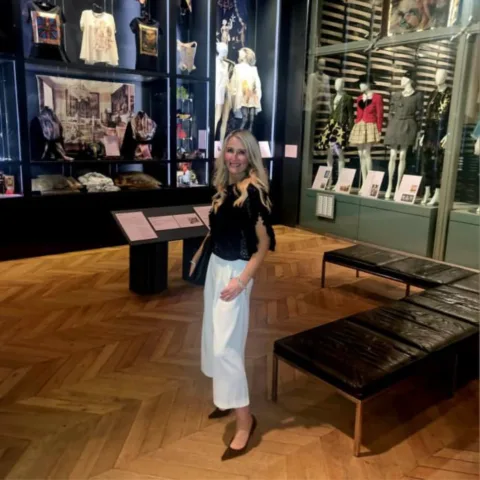The Bowes Museum Blog

The Emperor and the Everyman: Looking at Napoleon from a Different Perspective
Among the many Napoleonic objects collected by John and Joséphine Bowes is a charcoal and pencil sketch, simply titled Soldier resting.

Nicolas-Toussaint Charlet, Soldier resting, charcoal and pencil on paper, 30,8×22,5cm, B.M. 2005.21.6/D.A.
The soldier in question is a hussar of the Grande Armée, shown resting against a large rock inscribed with graffiti celebrating Napoleon: ‘Vive l’empereur!’ and a drawing of the imperial eagle. In the background is the unmistakable figure of the ‘Little Corporal’ himself, clad in his usual battlefield dress of grey overcoat and bicorn hat. The sketch appears both as a vignette from an unspecified campaign and as the nostalgic memory of an old soldier, reflecting on the loss of the ‘Man of Destiny’ who still looms large.
This drawing, now on display as part of The Allure of Napoleon exhibition, is one of several in the Bowes collections by Nicolas Charlet and his pupil, Denis-Auguste Raffet. Both artists contributed significantly to shaping the visual memory of the First French Empire through their images of the Grande Armée and of Napoleonic veterans. Charlet’s mother was devoted to Napoleon and his memory, and his father had actually served in the Grande Armée as a dragoon. In addition to depicting the Emperor himself, both Charlet and Raffet also specialised in images of Napoleon’s soldiers, capturing both their unwavering devotion to Napoleon and the suffering of many veterans during the Bourbon Restoration (1814-1830).

Portrait of a soldier by Denis-Auguste Raffet, ink on paper, 24,5 x 16cm, B.M. 2005.21.1/D.A.
This Charlet drawing is likely to date from either the late 1820s or the 1830s, reflecting the surge in the cult of Napoleon that occurred after the July Revolution of 1830. With the last Bourbon, Charles X, now replaced on the French throne by his cousin Louis-Philippe – a veteran of the Revolutionary Wars who was keen to make hay from the continuing popularity of Napoleon – Bonaparte became ubiquitous in the streets of Paris, as the figure of the Emperor (and his soldiers) reappeared in prints, figurines and other commemorative items. Napoleon was also resurrected on the Parisian stage, with over 120 new plays about him debuting in Paris in the period between 1830 and 1848. In December 1840, Napoleon’s remains finally returned to France from Saint Helena. After a spectacular procession through Paris, the Emperor was interred at the military hospital of Les Invalides.
With its focus on the figure of the soldier or veteran, Charlet’s Soldier resting highlights the importance of the ‘everyman’ in the Napoleonic legend as it developed over the course of the nineteenth and twentieth centuries. The use of the ‘everyman’ figure – often a soldier – served to underline the popularity of Napoleon with the men of the Grande Armée, and to present Bonaparte in a much more accessible and human way. This contrasted sharply with the often imperious portrayals of him as Emperor, such as the portrait of Napoleon as ‘sovereign legislator’ from the workshop of Anne-Louis Girodet. Thirty-six copies of this painting were commissioned in 1812, and one is in the Bowes Collection.

Workshop of Anne-Louis Girodet, Napoléon en souverain législateur (1812-14), B.M. 364
Compare this image of Napoleon, clad in imperial robes and surrounded by iconographical references to the classical past and to the ancient kings of France, to his appearance in this 1834 print by François Georgin. This is a typical example of the famous images d’Épinal (images from Épinal) that enjoyed such enormous popularity in nineteenth-century France.

François Georgin, Napoléon au siège de Toulon (1834), copyright Bibliothèque nationale de France
Georgin’s print depicts one of Napoleon’s earliest triumphs, coordinating the artillery assault on Toulon in 1793. Bonaparte – then twenty-two – does not dominate the image, with only the bicorn hat and familiar profile (as well as the fact that he is the only clean-shaven soldier in the image) serving to mark him out. Instead, he works as part of a team, supporting the gunners and keeping a close eye on their target.
Viewed from the perspective of the early 1830s, images like this simultaneously celebrated Napoleon’s brilliance and explained his lasting popularity with the rank and file by depicting him as a humble (if exceptionally talented) soldier. Later depictions of the Emperor often viewed him through the eyes of a veteran or other ‘everyman’ figure, echoing the nostalgic perspective of Charlet’s drawing. In Edmond Rostand’s celebrated play L’Aiglon, first performed in 1900 and starring Sarah Bernhardt in the role of Napoleon’s ill-fated son, the Duc de Reichstadt, the real hero of the story is neither Napoleon nor his heir, but a veteran of the Grande Armée named Séraphin Flambeau. In Napoléon, Abel Gance’s 1927 cinematic epic, the young Bonaparte’s only friend at military school (apart from an enormous pet eagle) is Tristan Fleuri, a lowly servant. Fleuri reappears later as the owner of a tavern in Toulon in 1793, just in time to cheer on his old friend as he inflicts defeat on the English and royalist forces.
These veterans and ‘everyman’ figures served an importance purpose in the creation of the Napoleonic legend through iconography, theatre, and later, film. In the years immediately following Napoleon’s downfall, they reflected French nostalgia for the glory days of the Empire and the Napoleonic Wars. Later depictions of Napoleon through the eyes of the ‘everyman’ allowed the Emperor to be celebrated, once again, as the ‘son of the Revolution’. Above all, however, these representations of Napoleon, his soldiers and his supporters served to humanise the Emperor after his downfall and death – in contrast, perhaps, to his own desire for a more imperial image.
By Dr Laura O’Brien, Lecturer in Modern European History, Northumbria University, Newcastle upon Tyne







